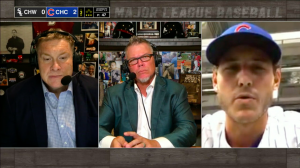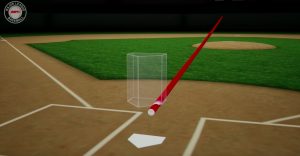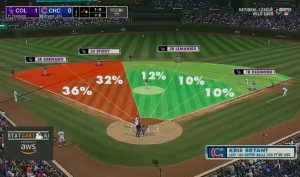MLB Returns: ESPN Preps Normal Sunday Night Baseball Graphics Package for ‘Enhanced World Feed’
At the mercy of local RSNs, the network will produce games via a clean feed
Story Highlights
“It’s going to be great, but, man, there have been a lot of Zoom calls and a lot of hours of work.”
In 22 words, Phil Orlins, senior coordinating producer, ESPN, summarizes the current era in live event production. After a fair amount of preparation in a time of much uncertainty, the broadcaster is fielding a full-fledged plan that features one of the largest REMI efforts out of its Bristol, CT, facility, complete with K-Zone and Statcast graphics and other technologies to improve a clean feed supplied by local regional sports networks.
Under One Roof: Production, Ops Teams Share Space in Bristol
Throughout the shortened, 60-game regular season, ESPN’s headquarters facility will be littered with personnel on both sides of the broadcast. On the operations side, a full crew usually seen in a mobile production unit in the compound will be housed in multiple control rooms. Even at the Bristol campus, broadcast teams will need to adhere to stringent health and safety guidelines to curb the spread of COVID-19. For example, one room may house only a TD, Producer Jeff Dufine, and Director Jeff Evers.

Working from their respective homes for ESPN’s coverage of KBO and MLB Summer Camp, Jon Sciambi (left) and Chipper Jones (center) interview Chicago Cubs star Anthony Rizzo.
On the production side, the main personalities typically seen in the booth will be located in Bristol. Play-by-play announcer Matt Vasgersian and analyst Alex Rodriguez will be using real-time monitors to call the action. Analyst Buster Olney will be in a very different environment if the stadium is relatively close to his home. When appropriate and in close proximity, he will drive to the stadium and find a safe location to report on the proceedings; if it’s not in driving distance, he will join the profusion of talent working remotely from home. For the non-exclusive games during the week, Baseball Tonight host Karl Ravech and play-by-play announcer Jon Sciambi will be on the call from Bristol.
If talent onsite or in the studio is not enough, other analysts will join from their homes, including Tim Kurkjian in Baltimore, Chipper Jones in Atlanta, Jessica Mendoza in Oregon, Rick Sutcliffe in San Diego, and Eduardo Perez in Miami. At-home commentators will be brought to the live broadcast via a TVU camera that is sent to Bristol on a one-second delay.
“We’ve had Major League Baseball on ESPN for a long time, and we are really excited to get going,” says Mark Gross, SVP, production and live events, ESPN. “We feel confident about the system and plan that we have in place.”
Welcome to @MLB Opening Night from Bristol @espnmikes @jksports pic.twitter.com/tp8ysHpiCl
— Mark Gross (@markgrossespn) July 23, 2020
One Way Street: ESPN To Rely on Local RSNs for World Feed
The COVID-19 pandemic has forced baseball stadiums across the nation to shut their doors and permit only extremely essential personnel inside, including a limited number of onsite production folks. With local RSNs getting the green light from the league, other national broadcasters are left on the outside looking in and relying on a clean video feed. This world feed will come with a complement of 12 cameras, including four with super-slow-motion capability, but, for what will most likely be the first time that MLB games are done via an enhanced world feed, the real ingenuity is in how the offsite team will see all aspects of the field through multiviewers created by Jason Hedgcock, director, remote technical operations, MLB Network.
“[Using a world feed] is not new to the broadcast industry,” says Orlins, “but it has crossed my mind that there could be some logic to having a primary broadcast for each game, relying on one set of coverage, and enhancing it from there. What’s new is trying to do it with 30 different RSNs.”
The process of getting on the same page with the participating networks was an entirely other challenge. For a team normally concerned with figuring out how logistically to showcase a game from different venues, ESPN will be working in conjunction with a new crew for every single telecast.
“It has taken an awful lot to build out, plan, and organize in what amounted to two weeks’ time,” Orlins explains. “We’ve conducted separate Zoom calls, once or twice every week, with Eastern, Central, and Western teams, and we’ve also done separate technical-only calls that have had anywhere from 250 to 300 participants.”
Nationwide Attention: Opening Day To Get Extra Treatment
Without an onsite crew, Orlins, Gross, and the team are bullish on the Sunday Night Baseball plan. Notable enhancements to the clean feed include three-dimensional K-Zone and Statcast AI technology powered by AWS. To further enhance the national telecasts, extra EVS servers will be on hand for additional replays. Other graphics efforts, such as specific placement of virtual advertising, are moving forward in standard fashion.
“There are plans to have some virtual advertising, but not necessarily in the seats,” notes Gross. “It’s comparable to what we’ve done regularly on a Sunday Night game.”
ESPN’s MLB coverage has become well-known for pushing the technological envelope every season. For this particular season, the biggest tech highlight is the installation of two cameras that will be controlled exclusively by ESPN on all non-exclusive weekday games.
“We can cut back and forth from [our two cameras] to whoever — manager, hitter, or pitcher — is being talked about,” says Orlins. “Then, we would essentially go back to the world feed to watch the game being covered.”
Lessons at Sunrise: KBO Productions Provides Much-Needed Insight

A regular since the 2015 regular season, K-Zone 3D will return to display the location and trajectory of every pitch.
Despite the nearly four-month postponement of the regular season, the MLB shortened season will not be ESPN’s first baseball production in the calendar year. After a deal was struck with the Korean Baseball Organization (KBO) at the midway point of the national sports shutdown, baseball fans in the U.S. were treated to a daily serving of professional baseball during the early hours of the morning.
Familiar sights included 4DReplay, which has become something of a staple on all of the network’s baseball properties, but one thing was unusual: getting a glimpse at the living quarters of on-air talent like Ravech, Perez, and Sciambi. Since some talent will continue to report from home, productions featuring this at-home style of commentary provided some valuable lessons learned in the leadup to MLB’s return.
“We ultimately learned how to optimize the home-broadcast experience because, on Day 1, the setup with 34-in. monitors and the Zoom layout with all of its capacities didn’t look like it does now,” says Orlins. “The KBO coverage has been interesting since we don’t have the same capacity that we have even on the non-exclusive regional games. With only one feed from Korea, we started doing some different things, like a slight compression to the screen and creating more graphics down the side. It will suit us well in the world-feed model.”
As for the piped-in crowd noise that each team will provide, it’ll be a drastic difference from what has been seen on the KBO telecasts. Rather than the more subdued Korean ballparks, the domestic venues will pack in the noise, thanks to the help of the massive audio catalogue of Sony’s MLB The Show videogame franchise.
“All of the stadiums will have crowd noise, their respective organists, and potentially their PA announcer,” says Gross. “We’re welcoming that because what we’ve learned from the KBO is that a little bit of crowd noise certainly goes a long way. When it comes to Major League Baseball games, we are not looking to fool anybody. We realize that there are no fans there, but having a little nat sound below the announcers [keeps the broadcasts from sounding] so hollow.”
Together at Home: A Potential To Deliver Intimate Production Moments

Powered by AWS, Statcast will continue to provide an alternative way to digest the game of baseball.
If 2020 could be encapsulated into an athletic season, it would quite possibly be this 60-game sprint to the postseason: a series of unforeseen ups and downs that force us to hunker down in our homes. It has also strongly altered the way broadcasts are traditionally done.
“We had never done games from people’s homes until a few months ago, so we’ve learned that technology is your best friend,” notes Gross. “[Production methods] are changing and will always continue to change. We’ve realized that just because you did it one way for years doesn’t mean you have to do it the same way now.”
Along with shifting production philosophies and operational strategies, special moments are poised to be forged from the most unusual settings.
“It’s all about the simple ability to access anybody who wants to call in with video on FaceTime or have that person call up the exact same Zoom feed that we’re working off on the computer,” says Orlins. “We’ll be able to take a person from anywhere in the world and put them on our show in a matter of a minute or two, not only to be able to talk to us in real time but also to see their reaction to a home run or things like that. It has been utterly game-changing for us.”
ESPN is serving up a doubleheader on Opening Day, starting with the New York Yankees facing the defending World Series Champion Washington Nationals in the nation’s capital at 7 p.m. ET and concluding with a West Coast game between the Los Angeles Dodgers and San Francisco Giants at 10 p.m.
Check out all of SVG’s ‘MLB Returns’ coverage:
- RSNs Take Over World Feed for All MLB Broadcasts, Customize for In-Market Fans
- ESPN Preps Normal Sunday Night Baseball Graphics Package for ‘Enhanced World Feed’
- Wearing Two Production Hats, MLB Network Deploys Full At-Home Model, Provides RSN Infrastructure
- Baseball Has Its Crowds on an iPad With Artificial Fan Noise
- As RSNs Handle World Feeds, Sinclair’s Fox Sports RSNs Shoulder Production Load
- NBC Sports Regional Networks Seeks Balance Between World Feed and Serving In-Market Fans
- NESN To Produce ‘Red Sox-ized’ In-Market Broadcasts in Addition to World Feed
- AT&T SportsNet RSNs Use Mix of Studio, Mobile Facilities for World Feed, In-Market Productions
- MASN Tested Early With Back-to-Back-to-Back World Feeds for National Broadcasts
- Fox Sports Augments MLB on Fox Telecasts With Virtual Fans
- …and stay tuned for more next week!
